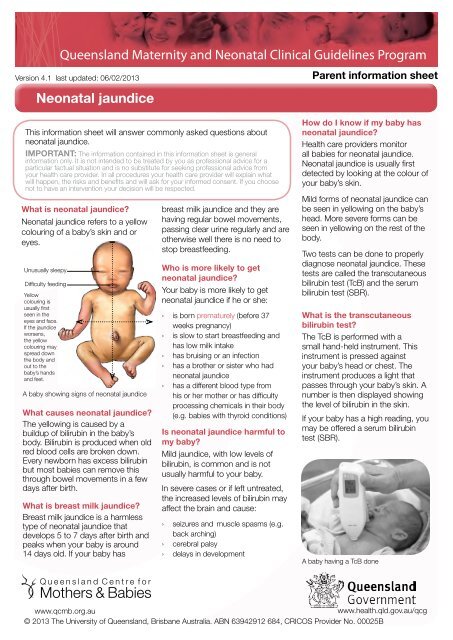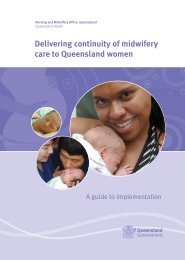Neonatal jaundice - Queensland Centre for Mothers & Babies
Neonatal jaundice - Queensland Centre for Mothers & Babies
Neonatal jaundice - Queensland Centre for Mothers & Babies
You also want an ePaper? Increase the reach of your titles
YUMPU automatically turns print PDFs into web optimized ePapers that Google loves.
<strong>Queensland</strong> Maternity and <strong>Neonatal</strong> Clinical Guidelines Program<br />
Version 4.1 last updated: 06/02/2013<br />
<strong>Neonatal</strong> <strong>jaundice</strong><br />
Parent in<strong>for</strong>mation sheet<br />
This in<strong>for</strong>mation sheet will answer commonly asked questions about<br />
neonatal <strong>jaundice</strong>.<br />
IMPORTANT: The in<strong>for</strong>mation contained in this in<strong>for</strong>mation sheet is general<br />
in<strong>for</strong>mation only. It is not intended to be treated by you as professional advice <strong>for</strong> a<br />
particular factual situation and is no substitute <strong>for</strong> seeking professional advice from<br />
your health care provider. In all procedures your health care provider will explain what<br />
will happen, the risks and benefits and will ask <strong>for</strong> your in<strong>for</strong>med consent. If you choose<br />
not to have an intervention your decision will be respected.<br />
What is neonatal <strong>jaundice</strong>?<br />
<strong>Neonatal</strong> <strong>jaundice</strong> refers to a yellow<br />
colouring of a baby’s skin and or<br />
eyes.<br />
Unusually sleepy<br />
Diffi culty feeding<br />
Yellow<br />
colouring is<br />
usually fi rst<br />
seen in the<br />
eyes and face.<br />
If the <strong>jaundice</strong><br />
worsens,<br />
the yellow<br />
colouring may<br />
spread down<br />
the body and<br />
out to the<br />
baby’s hands<br />
and feet.<br />
A baby showing signs of neonatal <strong>jaundice</strong><br />
What causes neonatal <strong>jaundice</strong>?<br />
The yellowing is caused by a<br />
buildup of bilirubin in the baby’s<br />
body. Bilirubin is produced when old<br />
red blood cells are broken down.<br />
Every newborn has excess bilirubin<br />
but most babies can remove this<br />
through bowel movements in a few<br />
days after birth.<br />
What is breast milk <strong>jaundice</strong>?<br />
Breast milk <strong>jaundice</strong> is a harmless<br />
type of neonatal <strong>jaundice</strong> that<br />
develops 5 to 7 days after birth and<br />
peaks when your baby is around<br />
14 days old. If your baby has<br />
breast milk <strong>jaundice</strong> and they are<br />
having regular bowel movements,<br />
passing clear urine regularly and are<br />
otherwise well there is no need to<br />
stop breastfeeding.<br />
Who is more likely to get<br />
neonatal <strong>jaundice</strong>?<br />
Your baby is more likely to get<br />
neonatal <strong>jaundice</strong> if he or she:<br />
›is › born prematurely (be<strong>for</strong>e 37<br />
weeks pregnancy)<br />
››<br />
is slow to start breastfeeding and<br />
has low milk intake<br />
››<br />
has bruising or an infection<br />
››<br />
has a brother or sister who had<br />
neonatal <strong>jaundice</strong><br />
››<br />
has a different blood type from<br />
his or her mother or has difficulty<br />
processing chemicals in their body<br />
(e.g. babies with thyroid conditions)<br />
Is neonatal <strong>jaundice</strong> harmful to<br />
my baby?<br />
Mild <strong>jaundice</strong>, with low levels of<br />
bilirubin, is common and is not<br />
usually harmful to your baby.<br />
In severe cases or if left untreated,<br />
the increased levels of bilirubin may<br />
affect the brain and cause:<br />
››<br />
seizures and muscle spasms (e.g.<br />
back arching)<br />
›cerebral › palsy<br />
››<br />
delays in development<br />
How do I know if my baby has<br />
neonatal <strong>jaundice</strong>?<br />
Health care providers monitor<br />
all babies <strong>for</strong> neonatal <strong>jaundice</strong>.<br />
<strong>Neonatal</strong> <strong>jaundice</strong> is usually first<br />
detected by looking at the colour of<br />
your baby’s skin.<br />
Mild <strong>for</strong>ms of neonatal <strong>jaundice</strong> can<br />
be seen in yellowing on the baby’s<br />
head. More severe <strong>for</strong>ms can be<br />
seen in yellowing on the rest of the<br />
body.<br />
Two tests can be done to properly<br />
diagnose neonatal <strong>jaundice</strong>. These<br />
tests are called the transcutaneous<br />
bilirubin test (TcB) and the serum<br />
bilirubin test (SBR).<br />
What is the transcutaneous<br />
bilirubin test?<br />
The TcB is per<strong>for</strong>med with a<br />
small hand-held instrument. This<br />
instrument is pressed against<br />
your baby’s head or chest. The<br />
instrument produces a light that<br />
passes through your baby’s skin. A<br />
number is then displayed showing<br />
the level of bilirubin in the skin.<br />
If your baby has a high reading, you<br />
may be offered a serum bilirubin<br />
test (SBR).<br />
A baby having a TcB done<br />
www.qcmb.org.au<br />
www.health.qld.gov.au/qcg<br />
© 2013 The University of <strong>Queensland</strong>, Brisbane Australia. ABN 63942912 684, CRICOS Provider No. 00025B
What is the SBR?<br />
The SBR involves testing a sample<br />
of your baby’s blood. Blood <strong>for</strong><br />
this test is usually taken by a<br />
needle prick on your baby’s heel.<br />
Depending on the level of bilirubin in<br />
your baby’s blood, your health care<br />
provider may offer treatment <strong>for</strong><br />
your baby’s <strong>jaundice</strong>.<br />
What is the treatment <strong>for</strong><br />
neonatal <strong>jaundice</strong>?<br />
Mild <strong>jaundice</strong> often goes away<br />
without treatment, however babies<br />
with high levels of bilirubin or severe<br />
<strong>jaundice</strong> may need treatment.<br />
Treatment depends on the level of<br />
bilirubin in your baby’s body and the<br />
cause of the <strong>jaundice</strong>. Treatments<br />
include phototherapy, exchange<br />
transfusion (only in severe cases) or<br />
medication.<br />
What will happen if my baby has<br />
phototherapy?<br />
Phototherapy is treatment with<br />
artificial lights that are usually blue<br />
but sometimes white. The light<br />
helps the baby’s body to break<br />
down the bilirubin so that it can<br />
be easily removed through bowel<br />
movements. Phototherapy is given<br />
either in the <strong>for</strong>m of overhead light,<br />
a biliblanket or a bilisoft. While your<br />
baby is are having treatment, your<br />
health care provider will monitor any<br />
changes in your baby’s skin colour,<br />
temperature, bowel movements,<br />
urine output and bilirubin in his or<br />
her blood.<br />
What are the possible side<br />
effects of phototherapy?<br />
Some of the possible side-effects of<br />
having phototherapy are:<br />
››<br />
Diarrhorea<br />
››<br />
Significant loss of water from the<br />
body via sweat, water in bowel<br />
movements, urine or breath<br />
››<br />
Bronze baby syndrome (condition<br />
where skin turns a bronze colour<br />
due to a buildup of iron in the body)<br />
What will happen if my baby has<br />
overhead phototherapy?<br />
Overhead phototherapy is normally<br />
done in a special care nursery<br />
or a paediatric ward within a<br />
hospital. Your baby may need to be<br />
transferred to a larger hospital <strong>for</strong><br />
treatment. Your baby will wear only<br />
a nappy while under the lights so<br />
that the maximum amount of skin is<br />
exposed to the light. Your baby will<br />
also wear an eye mask to protect<br />
his or her eyes from the artificial<br />
lights.<br />
A baby having overhead phototherapy<br />
What will happen if my baby has<br />
treatment with a biliblanket or<br />
bilisoft?<br />
A biliblanket is a stiff pad and a<br />
bilisoft is a soft pad, both have<br />
phototherapy lights in them. Your<br />
baby will be placed on or wrapped<br />
in the pad. The pad is attached by a<br />
cord to an electricity socket.<br />
Some hospitals may arrange to<br />
have this treatment done at home<br />
while other hospitals will do this<br />
treatment only in the hospital.<br />
Your baby can usually stay on or<br />
wrapped in the pad when feeding.<br />
Am I able to feed my baby<br />
during phototherapy?<br />
If your baby is receiving overhead<br />
phototherapy, this will be switched<br />
off during feeds. Your baby’s eye<br />
mask will also be removed so<br />
that you and your baby can see<br />
each other. The time spent out of<br />
overhead phototherapy should be<br />
monitored and kept to a minimum.<br />
Why are regular feeds important<br />
<strong>for</strong> babies with <strong>jaundice</strong>?<br />
It is important that babies who have<br />
<strong>jaundice</strong> are fed regularily, either<br />
demand feeding (feeding the baby<br />
as he or she shows signs of hunger)<br />
or at least every 3-4 hours. Regular<br />
feeds help the baby’s body digest<br />
and get rid of the bilirubin more<br />
quickly. Your health care provider<br />
will help you make sure your baby<br />
is getting enough fluid. They may<br />
suggest feeding your baby more<br />
often.<br />
When should I contact my<br />
health care provider?<br />
You should contact your health care<br />
provider if you notice your baby has:<br />
››<br />
yellowing of the skin<br />
››<br />
<strong>jaundice</strong> that re-appears after initial<br />
treatment (usually called rebound<br />
<strong>jaundice</strong>)<br />
››<br />
skin yellowing that is spreading<br />
further over their body<br />
››<br />
<strong>jaundice</strong> that is still there 14 days<br />
after birth<br />
››<br />
pale-coloured bowel motions<br />
››<br />
dark yellow urine or lack of urine<br />
››<br />
trouble feeding or is unwell<br />
Will my baby receive follow up?<br />
If your baby has had <strong>jaundice</strong> or<br />
has been treated <strong>for</strong> <strong>jaundice</strong>, you<br />
should arrange to have a follow up<br />
visit with your health care provider<br />
within 1-3 days after your baby has<br />
been discharged from hospital.<br />
At the follow-up visit your baby’s<br />
<strong>jaundice</strong> will be assessed along<br />
with their weight, feeding, urine and<br />
bowel movements. If your baby is<br />
showing signs of <strong>jaundice</strong> they may<br />
need further treatment in hospital.<br />
If you have comments about the<br />
content of this parent in<strong>for</strong>mation sheet<br />
please email info@qcmb.org.au<br />
Warning: <strong>Babies</strong> who have been wrapped in clothing stored with moth balls containing napthalene can<br />
develop severe <strong>jaundice</strong> and, in rare cases, brain damage. Parents should wash items that have been<br />
exposed to mothballs containing napthalene be<strong>for</strong>e use.<br />
Com<strong>for</strong>t, support & in<strong>for</strong>mation<br />
13 HEALTH (13 432584) is a phone line that provides health in<strong>for</strong>mation, referral and services to the public.<br />
Pregnancy, Birth & Baby Helpline 1800 882 436 (free call) offers free, confidential, professional in<strong>for</strong>mation and<br />
counselling <strong>for</strong> women, their partners and families relating to issues of conception, pregnancy, birthing and postnatal care.<br />
Lifeline 13 11 14 Lifeline offers a telephone crisis support service to anyone.

















